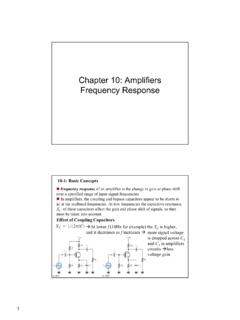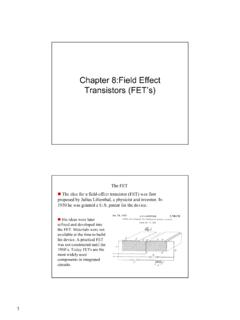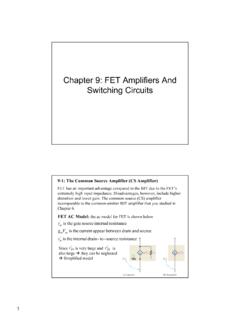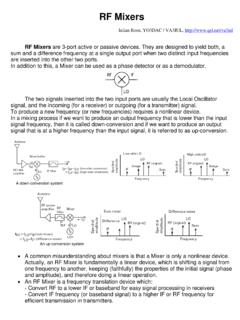Transcription of Chapter 13: Basic Op-Amp Circuits - An-Najah National ...
1 Chapter 13: Basic Op-AmpCircuits In the last Chapter , you learned about the principles, operation, and characteristics of the operational amplifier. Op-amps are used in such a wide variety of Circuits andapplications that it is impossible to cover all of them in one Chapter ,or even in one book. Therefore, in this Chapter , four fundamentallyimportant Circuits are covered to give you a foundation in op-ampcircuits. The Basic Circuits for Op-Amp s are1-Comparators2-Summing Amplifiers3-Integrators and : Comparators A comparatoris a specialized nonlinearop-amp circuit that compares between two input voltages and produces an output state that indicates which one is greater.
2 Comparators are designed to be fast and frequently have other capabilities to optimize the comparison function. In this application, the Op-Amp is used in the open-loop configuration, with the input voltage on one input and a reference voltage on the : ComparatorsZero-Level Detection One application of an Op-Amp used as a comparator is to determine when an input voltage exceeds a certain level The figure shown is the zero-level detector circuit; the inverting (-) input is grounded to produce a zero level (reference to compare Since Vinis at noninverting input As shown in figure.)
3 Any Vinabove the zero will produce a +ve saturated output (+Vout(max)) any Vinbelow the zero will produce a ve saturated output (-Vout(min)) Saturation of the output is due to the open-loop Op-Amp that have a very high voltage gain very small difference voltage between the two inputs drives the amplifier into saturation (non linear operation)with), and the input signal voltage is applied to the noninverting (+) inputSin : ComparatorsNonzero-Level Detection The reference voltage can be set to non zero voltage (+ve ot -ve) by adding a dc voltage or voltage divider or zener or.
4 VREF= VDCVREF= VZ As shown in the output voltage for given input (sinewave) Any voltage above VREF Voutwill be saturated +ve (Vout(max)) Any voltage Below VREF Voutwill be saturated -ve (Vout(min)) : ComparatorsNonzero-Level Detection: ExampleFor the given comparator and input signal, draw the output showing its proper relationship to the input signal. Assume the maximum output levels of the comparator are ; 14 : ComparatorsEffects of Input Noise on Comparator OperationIn many practical situations, noise (unwanted voltage fluctuations) appears (superimposed) on the input line we will have an erratic ( ) output voltage When the sine wave approaches 0, the fluctuations due to noise may cause the total input to vary above and below 0 several times, thus producing an erratic output voltage as shownWhen Voutis +Vout(max) UTP is set byReducing Noise Effects with Hysteresis Hysteresisis incorporated by adding regenerative (positive) feedback, which creates two switching points.
5 The upper trigger point (UTP) and the lower trgger point (LTP). After one trigger point is crossed, it becomes inactive and the other one becomes active. When Vinexceeds UTP, the output switches to the -Vout(max)When Voutis -Vout(max) LTP is set by When Vingoes below LTP, the output switches to the + Vout(max) : ComparatorsReducing Noise Effects with Hysteresis The amount of hysteresis is defined by the difference of the two trigger levels. A comparator with built-in hysteresis is sometimes known as a Schmitt trigger. Hence, the device triggers only once when UTP or LTP is reached as shown; thus, there is immunity to noise that is riding on the input : ComparatorsReducing Noise Effects with Hysteresis: ExampleDetermine the upper and lower trigger points for the comparator circuit in figure.
6 Assume that +Vout(max)= +5 V and -Vout(max)= : ComparatorsOutput Bounding In some applications, it is necessary to limit the output voltage levels of a comparator to a value less than that provided by the saturated Op-Amp . A process of limiting the output called boundingcan be used by adding a single zener diode to limit the output voltage to the zener voltage in one direction and to the forward diode voltage drop in the other direction. If zener anode is connected to inverting input (virtual ground, V = 0) when Voutis +ve, zener is reverse Vout= +VZ When Voutis ve, zener is forward Vout= positive bounded : ComparatorsOutput Bounding If zener is reversed, the result will be the inverse negative bounded out put Positive and negative bounded out put can be obtained by putting two back to back zeners as : ComparatorsOutput Bounding.
7 ExampleDetermine the output voltage waveformWe have zener diodes between input and output Bounded we have feedback to (+) Op-Amp input we have also hysteresis voltagesSince input voltage is at inverting (-) input V at ( ) = V at (+) = hysteresis voltage Hence Voutwill beVzeners +VhysterisiAt + ve Vout +Vout= VUPT + Vz2 + VUPT+ )( )(14747)(122outoutoutUPTVVVRRRV )( Same can be found when Voutis ve -Vout= : : ComparatorsComparator ApplicationsOver-Temperature Sensing Circuit For the shown bridge, R3= R4and R1is high (> R2) at normal temperatures V at (+) is lower than V at (-).
8 As the temperature increases, the resistance of the thermistor (R1) decreases V at (+) input increase. When the temperature reaches the critical value, R1becomes equal to R2, and the bridge becomes balanced (since R3= R4) . At this point the Op-Amp Voutswitches from low to its high saturated output level, turning Q1on. This energizes the relay, which can be used to activate an alarm or initiate an appropriate response to the over-temperature : ComparatorsComparator ApplicationsAnalog-to-Digital (A/D) Conversion The reference voltage for each comparator is set by the resistive voltage divider circuit and VREF.
9 The output of each comparator is connected to an input of the priority encoder. The priority encoder is a digital device that produces a binary number on its output representing the highest value inputThe encoder samples its input when a pulse occurs on the enable line (sampling pulse) Simultaneous or flash analog-to-digital converters (ADC) use 2n-1 comparators to convert an analog input to a digital value (n-digit binary number) for processing. Flash ADCs are a group of comparators connected in parallel, each with a slightly different reference voltage. The priority encoder produces an output equal to the highest value : Comparatorsfor the input signal in Figure below Determine the binary number sequence of the three-digit simultaneous ADC (Figure shown before).
10 Draw the resulting digital output waveforms. VREF= +8V011, 101, 110, 110, 100, 001, 000, 001, 010, 101, 110, 111 Digital : Summing Amplifiers The summing amplifier is an application of the inverting Op-Amp covered in Chapter 12. The averaging amplifier and the scaling amplifier are variations of the Basic summing Amplifier with Unity Gain A summing amplifierhas two or more inputs; normally all inputs have unity gain. The output is proportional to the negative of the algebraic sum of the unity gain inverting amplifierIn general, for n inputs : Summing AmplifiersSumming Amplifier with Unity Gain: ExampleDetermine the output voltage in : Summing AmplifiersSumming Amplifier with Gain Greater Than Unity When Rfis larger than the input resistors, the amplifier has a gain of Rf/R, where R is the value of each equal-value input resistor.


















